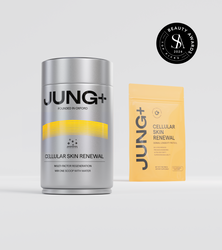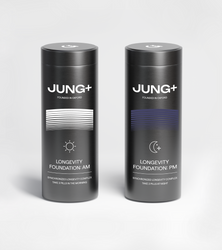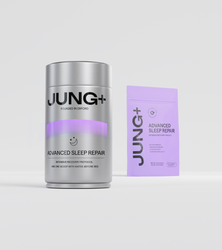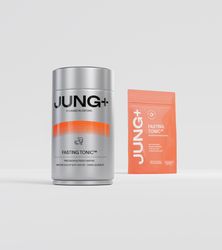Telomeres are among the most well-known structural components of chromosomes. Located at the ends of chromosomes, they protect them from sticking together and help ensure that the DNA strand is read correctly. In addition, telomeres serve as important markers of aging. Over time, they naturally shorten due to repeated cell divisions and oxidative stress, eventually causing the cell to die when it can no longer divide.
Astragalus, a powerful adaptogenic plant used for centuries in traditional Chinese medicine, has gained attention from researchers as a promising natural compound for telomere support and cellular defense.
Below, we'll explore the science behind astragalus and its effects on telomere health. We'll also examine why it has garnered interest for its potential to promote cellular longevity and overall well-being.
Understanding Astragalus and Telomeres
Astragalus is a large genus of plants in the legume family with many familiar names: milkvetch (most species), burdock (some species in North America), and goatgrass (A. gummifer, A. tragacantha).
The species of astragalus, commonly known as Mongolian milkvetch, is a well-known adaptogenic herb that is highly valued in traditional Chinese medicine. Astragalus root is one of the fifty “fundamental herbs” in traditional Chinese medicine, where it has been used for thousands of years to strengthen the immune system, increase vitality, and promote longevity. Often called “Huang Qi” (A. propinquus), it's traditionally prescribed to combat fatigue, enhance energy, and protect against disease.
What accounts for the benefits of astragalus? Around 27 polysaccharides, 63 flavonoids, and more than 161 saponins—such as astragaloside IV and cycloastragenol—are distributed throughout the roots, stems, leaves, flowers, fruits, and seeds. These compounds are largely responsible for astragalus’s medicinal properties (1). The abundance of these constituents has made astragalus a focal point of modern research into aging and cellular health.
What Are Telomeres and Why Are They Important?
All genetic information necessary for normal function and life is stored in DNA, which is comprised of thin strands of alternating nucleotide sequences. The total length of DNA in a single human cell is about two meters, yet it fits inside a nucleus that’s roughly 300,000 times smaller.
This is possible because DNA forms various three-dimensional structures. The phenomenon of tightly packed DNA is called condensation, and it is this condensation that forms chromosomes.
Because of the complexity of DNA packaging, chromosomes have a special structure that allows DNA to weave in and out as it's read. Large protein complexes, like trains on a track, travel along the DNA to facilitate this process. Telomeres exist to prevent these complexes from “falling off” the ends of DNA strands (2). Think of telomeres as a depot at the end of the track where the train can turn around. Without that depot, the train can’t complete its route.
With each round of cell division, telomeres naturally shorten. Over time, this shortening becomes significant, leading to cell senescence (aging) or apoptosis (cell death), as the cell’s ability to divide and synthesize proteins becomes impaired.
Telomere length is now considered a key biomarker of biological aging. Shorter telomeres are associated with:
-
Accelerated aging and tissue dysfunction;
-
Age-related diseases such as cardiovascular disease, neurodegeneration, and cancer;
-
Decreased cellular renewal, affecting organs, the immune system, and overall vitality.
In essence, telomeres act as a biological clock, reflecting the combined effects of aging, oxidative stress, and lifestyle factors on our cells. This explains why slowing telomere shortening or promoting telomere repair has become central to longevity research.
How Astragalus Impacts Telomere Length and Cellular Aging
Astragalus has been shown to have a unique ability to support telomere health and cellular longevity (3). This benefit is primarily linked to astragalus’s ability to activate telomerase, an enzyme that maintains and extends telomeres (4).
Telomerase helps preserve telomere length by adding repetitive nucleotide sequences to chromosome ends, effectively "repairing" them and preventing premature aging. In most somatic (body) cells, telomerase activity is low or absent, which leads to gradual telomere shortening and, eventually, cell death.
However, in certain cells, such as stem cells, germ cells (sperm and egg), and cancer cells, telomerase activity remains high, helping maintain telomere length and enabling continued cell division.
The Science of Astragalus and Telomere Lengthening
The telomere-protective effects of astragalus are primarily attributed to its bioactive compounds:
-
Cycloastragenol: A triterpenoid isolated from various Astragalus species, reported to have telomerase activation activity.
-
Astragalosides: These saponins—particularly astragaloside IV—have antioxidant and anti-inflammatory properties that help reduce oxidative stress, a major factor in telomere damage.
How Astragalus Supports Telomere Health
Astragaloside IV and cycloastragenol may activate specific signaling pathways that increase transcription of the TERT gene, which codes for the catalytic subunit of telomerase. Once activated, telomerase production increases (5).
Additionally, in vitro studies on human CD4 and CD8 T-cells found that cycloastragenol may moderately increase telomerase activity and delay cellular senescence (6).
The Need for More Research:
Although evidence suggests astragalus may support telomere health, large-scale placebo-controlled clinical trials remain limited. More studies are needed to confirm its efficacy and long-term effects on telomere elongation and cellular longevity.
Health Benefits of Astragalus Beyond Telomeres
While astragalus is well-known for its potential telomere and anti-aging benefits, its actions go far beyond cellular aging. As a potent adaptogen with a long history of use, it offers broad benefits for immune health, energy, stress resilience, and more (1).
Immune System Support:
Astragalus is known for its immune-enhancing properties. It supports the immune system by:
-
Promoting white blood cell activity (including macrophages, T cells, and NK cells)
-
Regulating cytokine levels to reduce excessive inflammation
-
Enhancing antiviral defense via increased interferon production
-
Inhibiting inflammatory pathways, lowering markers like TNF-α and IL-6
Oxidative Defense:
Astragalus helps protect cells and tissues by:
-
Scavenging free radicals
-
Enhancing antioxidant enzymes such as superoxide dismutase
Cardiovascular Support:
Astragalus also supports heart and blood vessel health:
-
Improves cardiac output and heart function (especially in those with heart failure)
-
Acts as a natural vasodilator, helping regulate blood pressure
-
Improves cholesterol balance, reducing LDL and increasing HDL
Energy and Stress Adaptation:
As an adaptogen, astragalus helps the body handle stress and maintain vitality:
-
Supports mitochondrial energy production
-
Regulates cortisol, reducing stress-related fatigue and improving focus
Kidney Health and Detoxification:
Astragalus supports detoxification and kidney function:
-
Improves glomerular filtration rate
-
Reduces urinary protein loss in those with kidney disease
Gut Health:
Astragalus polysaccharides act as prebiotics, which:
-
Nourish beneficial gut bacteria
-
Support immune function via gut-associated lymphoid tissue
-
Inhibit harmful microbes (7)
How to Incorporate Astragalus into Your Longevity Plan
To benefit from astragalus, choosing the right form, dosage, and timing is essential. We’ve also discussed why timing matters [here].
Choosing the Right Form of Astragalus:
-
Root extract: Traditional form used in teas or decoctions
-
Capsules/Tablets: Standardized doses of extract or active compounds
-
Tinctures: Fast-absorbing and adjustable
-
Powder: Can be added to food or beverages
Optimal Dosage and Timing:
Dosage can range from 10 mg (for concentrated cycloastragenol) to 1,000 mg per day, with 100–200 mg being optimal in many cases.
Astragalus is best taken in the evening or before bed to support repair and regeneration during sleep, when autophagy and cellular healing are most active.
Integrating Astragalus with Other Supplements:
Astragalus pairs well with other longevity ingredients like pterostilbene and niacin. Always consult a qualified practitioner to ensure safe, effective combinations.
Potential Risks and Considerations
Astragalus can potentially interact with other conditions:
-
Autoimmune conditions: Astragalus may overstimulate the immune system—consult your doctor if you take immunosuppressants.
-
Blood sugar and blood pressure: Astragalus may lower both; monitor if you're on related meds.
-
Pregnancy and breastfeeding: Safety not well established—avoid unless advised by a professional.
-
Digestive sensitivity: Some users may experience mild GI discomfort.
Long-Term Use:
Astragalus has a long history of use, but clinical data on long-term supplementation is limited. Start low, monitor your response, and work with a healthcare provider to ensure safety.
Astragalus in Longevity Foundation Products
Jung+ Longevity Foundation targets the 12 root causes of aging. It includes both daytime and nighttime formulas.
The nighttime formula includes:
-
Spermidine, olive leaf (oleuropein), zinc gluconate, chondroitin sulfate, apigenin, and astragalus root extract
-
Zinc: Supports muscle repair and protein synthesis
-
Chondroitin sulfate: Promotes joint health and flexibility
-
Astragalus: Adds anti-inflammatory and regenerative support
Further research into astragalus is critical to advancing natural longevity solutions. Its role in combating oxidative stress, supporting immune function, and preserving telomeres makes it a promising candidate for long-term health optimization.
By combining ancient herbal wisdom with cutting-edge science, astragalus is positioned to become a foundational tool in natural anti-aging strategies, offering a powerful, evidence-based path to a longer, healthier life.
References:
-
Biosynthesis and Pharmacological Activities of Flavonoids, Triterpene Saponins and Polysaccharides Derived from Astragalus membranaceus (2023). Molecules.
-
Telomeres, lifestyle, cancer, and aging (2012). Current Opinion in Clinical Nutrition and Metabolic Care.
-
The Use of Natural Agents to Counteract Telomere Shortening: Effects of a Multi-Component Extract of Astragalus mongholicus Bunge and Danazol (2020). Biomedicines.
-
Telomerase-based pharmacologic enhancement of antiviral function of human CD8+ T lymphocytes (2008). The Journal of Immunology.
-
Cycloastragenol and Astragaloside IV activate telomerase and protect nucleus pulposus cells against high glucose-induced senescence and apoptosis (2021). Experimental and Therapeutic Medicine.
-
Cycloastragenol: An exciting novel candidate for age‑associated diseases (2018). Experimental and Therapeutic Medicine.
-
Gut microbiota mediated hypoglycemic effect of Astragalus membranaceus polysaccharides in db/db mice (2022). Frontiers in Pharmacology.




